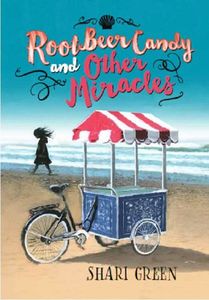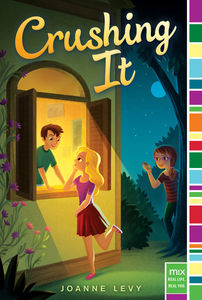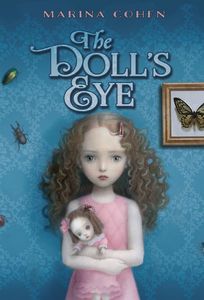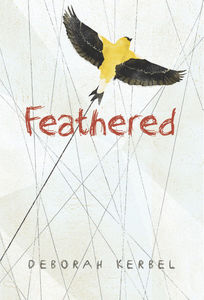Kid Lit Can: Spotlight on Middle Grade Fiction - Part 1
By Susan Hughes
Happy 2017! This month and next, I’m spotlighting middle-grade (MG) novels -- stories written for readers who are generally within the 7 to 12-year-old age range.
I’ve written one MG novel (Island Horse), I’m working on a new one, and I’ve critiqued dozens of them. Why do I love MG so much?
Well, the age range for MG is so broad that it opens up huge story possibilities. In fact, almost anything goes -- as long as you tell a story that will interest a segment of this audience without talking up or down to them, and oh, while remembering that the readers aren’t yet teens.
Easy-peasy, right?
Well, Shari Green, Joanne Levy, Marina Cohen, and Deborah Kerbel sure manage to make it look that way! Today I’m fortunate to chat with these four fantabulous authors about their newest MG novels, their writing processes, and more!
Susan:
Can you each tell us something about your newest MG book please? (Feel free to brag!)
Shari:
Root Beer Candy and Other Miracles is a story about family, community, the possibility of miracles, and, most of all, learning to see the extraordinary in the ordinary. And the beach!—it’s about the beach! J It’s perhaps the most “me” thing I’ve written (so far), in that the themes reflect so much about who I am.
Joanne:
Crushing It is a middle grade take on the old Cyrano de Bergerac tale but with a gender twist. Kat doesn’t think the cute boy next door would ever be into her nerdy self, so, against her better judgement, she helps dupe him into asking her BFF to the school dance. The girls devise ridiculous plots to make it happen—some with success, some not so much; hilarity ensues!
Marina:
The Doll’s Eye tells the story of 12 year-old Hadley who, after moving in to a big old house with her new stepfather and stepbrother, finds herself lamenting the loss of her old life. When a lone glass eye rolls out from a dark corner underneath her bed, things begin to change, though not necessarily for the better. A second narrative weaves its way through the novel—that of the first girl who lived in the house and the evil she unwittingly unleashed. It’s a tale of wish fulfilment and consequence, of innocence and happiness.
Your CanLit News
Subscribe to Open Book’s newsletter to get local book events, literary content, writing tips, and more in your inbox
Deborah:
Set in 1980 during the time of Terry Fox’s Marathon of Hope, Feathered is the story of eleven-year old Finch and her struggles at home and in the sixth grade. Her dad died last year and her mom hasn't been the same since, her best friend dropped her, and her brother's awful classmate is too mean for words. Finch thinks there couldn’t be a better time to fly away from her life. But when something terrible happens to a new friend and it seems Finch may be the only one who can help, she comes to understand that flying is not the answer --- sometimes right where you are is the best place to be.
Susan:
Joanne, you’ve dabbled in writing YA short stories and Shari, Marina, and Deborah, you’ve each written one or more YA novel. So, how did you each come to write your latest novels for an MG audience?
Shari:
When I began writing RBCAOM, my brain was definitely still in YA-land—Bailey, the main character, started out as a 17-year-old. However, the voice wouldn’t click for me until I realized she was only 11. Seeing the world of RBCAOM through the eyes of an 11-year-old made all the difference, and the story took off.
Joanne:
Yes, my first published novel, Small Medium At Large, was also a middle grade, though it started out as YA (long story). But for Crushing It my agent had pitched a different MG novel to my editor at Simon & Schuster. She didn’t connect with that book, but liked my voice, so she remembered me when the concept for Crushing It came up and she was looking for authors to submit samples for it. I must have impressed her with my sample, because I got the project!
Marina:
Though I’ve written two YA novels, Ghost Ride and Mind Gap, I consider them both to be more upper middle grade than true YA. I’m not really sure why, but when stories come to me, they come to me in a middle grade voice. It may be because truly terrifying horror as seen through innocent eyes can be even more frightening.
Deborah:
Well, I don’t often begin writing a new book with the audience’s age in mind. What usually comes first is a spark of an idea along with (hopefully) a strong character who will run with it. Once I’ve figured out the personality and voice of the character, I get a sense of her age. Only at that point does the manuscript become MG or YA (or sometimes PB). With Feathered, Finch’s voice very clearly belonged to a middle-schooler. Right from the get-go.
Susan:
RBCAOM is written in verse. Wow! Shari, can you tell us what your writing process was like?
Shari:
By the time I wrote RBCAOM, my natural writing style had settled into one that was fairly lean and lyrical, so the switch from prose to verse felt completely natural. However, I hadn’t planned to write in verse—it was simply how I heard Bailey’s voice (once I’d finally figured out she wasn’t seventeen!). Who was I to argue with the main character?!
In hindsight, I know there are other reasons verse was the right format for the story: I felt complete freedom to use imagery to weave the ocean setting throughout, and I was able to use white space to encourage readers to ponder their own beliefs and to think about the ambiguities and unanswered questions of the story. I didn’t think much about the market while writing—if I had, I probably would’ve been swamped by self-doubt!
Susan:
Crushing It has been described as the “perfect laugh-out-loud read.” Joanne, does writing humour come naturally to you?
Joanne:
Humour does come naturally to me. I’m a pretty funny person; people tell me I am, so I feel comfortable with that fact (though not so comfortable with the immodesty of saying it).
Since I knew Crushing It was going to be published for a tween imprint known for fun stories, it was important that the book be humourous. It’s not too much of a struggle to maintain that humour throughout—I just look for comedy in everyday things. I remember being a tween and how ridiculous and embarrassing life can be at that age so I take scenarios and find the humour in them. Also, it helps that most of my characters have a good sense of humour; I have fun with that, too.
Susan:
Marina, you’ve referred to The Doll’s Eye as “creepy.” Your other stories are also fantastical with elements of darkness within. Why do you almost exclusively write in the genre of “creepy”?
Marina:
Writers write what they like to read and ever since I can remember, I’ve been a huge fan of horror, mystery, and fantasy. Perhaps it’s because I grew up in a sprawling suburbia and these sorts of stories presented me with a thrilling escape. One way I try to sustain creepiness is by knowing my ending from the get-go and building slowly, steadily toward it. Though my newest manuscript is yet another creepy middle grade, I am toying with an idea that is quite painfully realistic. I’m not sure I’m suited to write this story, but I’m hoping.
Susan:
Feathered is being catalogued as historical fiction? Really? And yet … I was alive during those years, the 1980s. You?
Deborah:
Feathered takes place in the late summer and fall of 1980. And yes, shockingly, some reviewers are categorizing it as historical fiction. I was nine years old in 1980 — just a couple of years younger than Finch and right on the cusp of those oh-so formative middle-school years — so I remember that time very well. Which definitely made it much easier to create her world authentically. If you were a kid during the 80’s, you’ll recognize some ‘historical’ references when you read the book. Things like Frisbees, Kool-Aid, and Love’s Baby Soft perfume. Also, Finch's mom drives a Dodge Dart. Her older brother has a Sony Walkman, a Star Wars sheet set, and a Rubik’s Cube. Terry Fox is also a pivotal figure in the story. And Finch’s favourite TV show? 'Little House on the Prairie' of course!
Susan:
And now, MG authors, please tell us something about how your newest MG novel came to be published.
Shari:
I spent maybe a year writing Root Beer Candy—drafting the story, doing my own revisions, then revising again based on feedback from my critique partners. I entered it in “PitchWars,” an online contest that pairs winning writers with a mentor, and was fortunate to be matched with a mentor who helped me whip the manuscript into shape for agents’ eyes. I ended up submitting it to Pajama Press myself, though, and was thrilled to be offered a contract with them. I did one final round of revisions with my editor before the book came out in September.
Joanne:
As I mentioned, my editor at Simon and Schuster approached my agent after reading (and declining) one of my other manuscripts. She supplied an outline and I wrote to it. I’m a pretty literal person, so I stuck closely to that outline and the writing came easy – it was about a month to write the draft, start to finish. I think it ended up being about 40 000 words when I was done. Needless to say, I’m a fast writer, though I will say having that outline really helped.
Revisions were fairly straightforward and I had no issues. Honestly, the entire process was great and almost felt too easy (not that I’m complaining!). I felt my editor and I were on the same page from day one and it all fell into place.
Marina:
Oh my. It’s a long story so here’s the short version: I wrote The Doll’s Eye before I wrote The Inn Between. It was the manuscript that garnered the attention of my amazing agent and for that I’m so very grateful. I spent nearly a year revising it for him, but when it was finally submitted it didn’t sell. Devastated, I set it aside and wrote The Inn Between. When it sold in a two-book deal, I decided to have one final look at The Doll’s Eye before giving up on it entirely, and wham! It hit me. I finally knew what was wrong with the story. I tore it apart and rebuilt it word by word. The plot changed dramatically. I am not only extremely grateful to my editor for loving it but to those who passed on it because they forced me to write a better story.
Deborah:
I started writing Feathered in the spring of 2013. Inspired by a news item I’d read, I imagined a scene about a girl named Finch who, after pulling a feather out of her neck several years before, believes she’s destined to fly. From the very first page, the story took on a life of its own. Finch’s voice was so strong and clear, it was like I was channeling a spirit. I had the first draft finished after three weeks of frenzied writing. The revision process with my agent took about six months. And then roughly another six before the contract was signed with my publisher.
Look for Part 2 of this middle grade fiction spotlight, coming in March...
Shari Green is in love with stories and the sea. She lives in Campbell River, BC, with her husband, kids, and the worst watchdog ever. Visit her online at www.sharigreen.com.
Joanne Levy is the author of two MG novels. She lives in Ontario, Canada with her husband, Labrador Retriever, African Grey Parrot, and two cats, one of whom vomited during the writing of this bio. Visit her online at www.joannelevy.com
Marina Cohen lives in Markham, Ontario, where she spends far too much time asking herself, “What if?” Her website is www.marinacohen.com
Deborah Kerbel is the author of six novels for young adult and middle grade readers. In real life, she lives in Thornhill, Ontario with her husband, two kids, and a rescued Schnoodle named Alfredo. Online, she lives at www.DeborahKerbel.com or @DeborahKerbel.
The views expressed by Open Book columnists are those held by the authors and do not necessarily reflect the views of Open Book.
Susan Hughes is an award-winning author of children's books — both fiction and non-fiction — including The Island Horse, Off to Class, Case Closed?, No Girls Allowed and Earth to Audrey. She is also an editor, journalist and manuscript evaluator. Susan lives in Toronto. Visit her website, www.susanhughes.ca.






